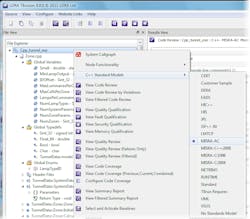Originally created as a way to promote best practices in developing safety-related electronic systems in the automotive industry, MISRA (Motor Industry Software Reliability Association) has since become a standard adopted for the use of embedded systems in multiple industries, including aerospace, medical and rail. To help manufacturers, component suppliers and engineering consultancies collaborate on the development of these safety-related embedded systems, MISRA publishes documents that provide information for engineers and manufacturing management.
MISRA Autocode (AC) is a set of guidelines for users of modeling tools. The guidelines are said to encourage good modeling practices and avoid poorly defined features of the modeling language. MISRA AC rules (which provide a framework for following the guidelines of MISRA-C:2004) are specific to the use of automatic code generators in the development of safety-related systems.
As part of the LDRA tool suite (offered by LDRA, a provider of software that automates code analysis and software testing for safety-, mission-, security- and business-critical markets), developers can decide which individual MISRA AC rules apply to their project code generator and whether additional rules are required at the model level to address deviations from any given MISRA C rule. This ability allows for the creation of either a superset or subset of the standard managed by the LDRA tool suite.
"With companies such as General Motors, NASA, and Lear generating large quantities of code from model-driven design, there’s a need for software testing and verification suites that integrate the model and its generated code into the overall testing process," said Ian Hennell, LDRA operations director. "Within the LDRA tool suite, all aspects of the model, automatically generated code, test cases and requirements are verified and independently shown to meet compliance standards. MISRA AC assists in that overall verification process."
Building on the requirements traceability supported within the LDRA tool suite, all model and autocode artifacts become part of the overall requirements traceability matrix, enabling developers to trace the fulfillment of requirements through model, code, and tests in the overall software development process. This means that developers can pinpoint unfulfilled requirements and failed tests and drill down to the relevant code, thereby speeding the overall testing process.
Hennell adds, "The MISRA standard draws together programming guidelines that help reduce the number of defects found in code. Once the model is proven to generate code correctly, the percentage of errors drops even more."
LDRA Software Technology
www.ldra.com/misraac.asp
MISRA Autocode (AC) is a set of guidelines for users of modeling tools. The guidelines are said to encourage good modeling practices and avoid poorly defined features of the modeling language. MISRA AC rules (which provide a framework for following the guidelines of MISRA-C:2004) are specific to the use of automatic code generators in the development of safety-related systems.
As part of the LDRA tool suite (offered by LDRA, a provider of software that automates code analysis and software testing for safety-, mission-, security- and business-critical markets), developers can decide which individual MISRA AC rules apply to their project code generator and whether additional rules are required at the model level to address deviations from any given MISRA C rule. This ability allows for the creation of either a superset or subset of the standard managed by the LDRA tool suite.
"With companies such as General Motors, NASA, and Lear generating large quantities of code from model-driven design, there’s a need for software testing and verification suites that integrate the model and its generated code into the overall testing process," said Ian Hennell, LDRA operations director. "Within the LDRA tool suite, all aspects of the model, automatically generated code, test cases and requirements are verified and independently shown to meet compliance standards. MISRA AC assists in that overall verification process."
Building on the requirements traceability supported within the LDRA tool suite, all model and autocode artifacts become part of the overall requirements traceability matrix, enabling developers to trace the fulfillment of requirements through model, code, and tests in the overall software development process. This means that developers can pinpoint unfulfilled requirements and failed tests and drill down to the relevant code, thereby speeding the overall testing process.
Hennell adds, "The MISRA standard draws together programming guidelines that help reduce the number of defects found in code. Once the model is proven to generate code correctly, the percentage of errors drops even more."
LDRA Software Technology
www.ldra.com/misraac.asp
About the Author
David Greenfield, editor in chief
Editor in Chief
David Greenfield joined Automation World in June 2011. Bringing a wealth of industry knowledge and media experience to his position, David’s contributions can be found in AW’s print and online editions and custom projects. Earlier in his career, David was Editorial Director of Design News at UBM Electronics, and prior to joining UBM, he was Editorial Director of Control Engineering at Reed Business Information, where he also worked on Manufacturing Business Technology as Publisher.
Sign up for our eNewsletters
Get the latest news and updates

Leaders relevant to this article:
